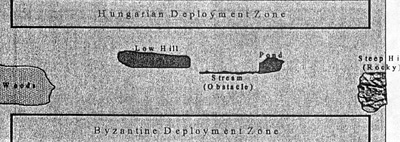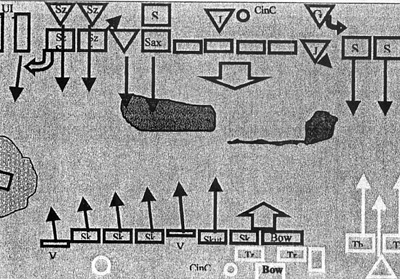On a cool Sunday afternoon in my basement… err, rather in rolling hill country near the Danube… the Byzantine Army prepared to face its first major threat in Europe since the conquest and destruction of their long time Bulgarian foe. The Hungarians had found themselves a war leader capable of fielding and sustaining a large well-equipped army that could not be bribed, cajoled or otherwise indirectly sent packing. Today would be the day…
The Byzantine commander was able to find a battleground with anchoring terrain on both flanks to reduce the effect of Hungarian numbers, particularly their clouds of lightly equipped horse archers. Terrain and deployment zones are listed below.
The Byzantines were confident in the ability of their well-trained and heavily equipped infantry to fend off Hungarian attacks, particularly the pesky but light skirmish bow cavalry which were the most notable features of past Hungarian armies. The basic plan was to anchor the left side with skirmish bow in ambush in the woods and a line of Varangians and Skutatoi running to the stream which would be held by bowmen. Tagmatic Lancers and Thematic cavalry would lead the advance on the right with the remaining Tagmatic Lancers under the right flank General in close support. Tagmatic bow armed cavalry and lance armed Trapezetoi light horse formed the reserve stationed in the right center.
 The Hungarians deployed their heaviest and most potent cavalry in the largest open area of the battlefield that proved to be where the Byzantine infantry was stationed. After placing their light troops in two columns facing the woods they deployed the fanatic Szekely cavalry, with skirmishers in front and heavy lancers behind. Next came the flank general with heavily armored noble lancers and a block of heavy Saxon cavalry. The Hungarian peasant spearmen occupied the rest of the center across from Skutatoi and the Byzantine archers.
The Hungarians deployed their heaviest and most potent cavalry in the largest open area of the battlefield that proved to be where the Byzantine infantry was stationed. After placing their light troops in two columns facing the woods they deployed the fanatic Szekely cavalry, with skirmishers in front and heavy lancers behind. Next came the flank general with heavily armored noble lancers and a block of heavy Saxon cavalry. The Hungarian peasant spearmen occupied the rest of the center across from Skutatoi and the Byzantine archers.
The gap between water and the rocky hills was to be covered by 3 units of horse archers. A horse archer unit provided a reserve behind the heavy Hungarian cavalry while the Hungarian CinC kept a unit of javelin armed cavalry near him in the center, and the horse archers could call on another unit of javelin armed cavalry or the rest of the Hungarian nobles riding with the general on their flank.
As the Byzantines sought to establish their cordon of foot on the left the Hungarians swung the Szekely skirmishers out of line and proceeded to a direct full strength assault 4 units abreast. The horse archers moved up in hopes of slowing the Byzantine mounted attack and perhaps weakening it sufficiently that the general and his reserves could deal with any penetrations.
 After the second turn the Hungarian charge was set with skirmish cavalry in support on either side. On the other flank the horse archers had traded initial volleys with the Byzantine heavies.
After the second turn the Hungarian charge was set with skirmish cavalry in support on either side. On the other flank the horse archers had traded initial volleys with the Byzantine heavies.
The battle turned ugly very quickly as the next turn saw the Hungarian frenzied charge throw back all three skutatoi on the left side of the Byzantine line with heavy losses. The intrepid footsoldiers did not break, but they were clearly in desperate trouble. The Thematic lancers, meanwhile, were peppered with arrows from two units while drawing into a tighter attack formation and temporarily sent reeling back from the fray (lost a stand and rolled a 1). The third horse archer unit, despite losing half of their strength over two turns of trading bowfire with the Thematics, retired in good order.
On the next turn, the Hungarians gained the initiative on the stunned Byzantines and delivered a stinging javelin assault on the Thematics sending them back to rally on the general and the Tagmatic lancers (another stand loss, another 1). The Byzantine Strategos (CinC) didn't have time to be dismayed at this unfortunate turn of events. Even as he set his reserves in motion, and the left flank general sent in the Varangians to stem the Hungarian flood tide, the leftmost skutatoi unit cracked under the strain of 50% losses.
The other skutatoi, already battered and reeling followed suit leaving a gaping 250-yd hole in the Byzantine left. Having already wisely withdrawn the archers from the line of the stream the Strategos ordered an immediate withdrawal from his totally untenable position. The Trapezetoi and Tagmatic bow cavalry would attempt to provide cover as the remaining infantry (still unengaged) pulled out and the right wing, still well able to defend itself kept the horse archers from running amok and creating havoc among the dazed and confused survivors…
This battle ended in a rout of the Byzantines in short order, but it didn't have to and, in fact, almost every break went the Hungarians way (not even mentioning the two morale rolls for the Byzantine cavalry). Against the Skutatoi the Hungarian charge dice and random die rolls were above average and the general and the Saxon cavalry had no problem becoming frenzied. The Byzantine deployment was flawed in having the Trapezetoi and bow Tagmatics in the rear instead of leading the mounted assault against the horse archers – against whom they would have been ideally suited.
Unfortunately, the Skutatoi were not designed to stand against the heavy assault to which they were subjected. They can well fend off light horse and lightly armored, javelin armed cavalry such as those they faced from Arab armies or the Bulgarians. The extra weight and ferocity of the Hungarian assault were too much and should lead to the writing of a new chapter in the Byzantine military manual calling for additional ranks of spearmen to blunt these charges.
The items playtested in this battle were modifications to missile fire rules. Arrow barrages are limited to 1 1/2 dice per stand rather than 2 and two modifiers were changed. Rather than giving a –1 when firing against shieldless targets a +1 is used against shielded targets. As a partial counterbalance, and for consistency with Ancient Warfare I suppose, unarmored targets have a –2 modifier rather than being lumped in with lightly armored troops at –1.
We found that despite the 'downgrading' of missile fire units could be, and were, chewed up over a reasonable amount of time. The Skutatoi should not have been able to shoot their opponents out of the saddle with only one line of archers and, though they caused casualties, they did not stop them. The archer unit in the middle shot holes in the Hungarian spearmen and caused one unit to retire in disorder which was reasonable for the amount of fire they could bring to bear.
The success of the Hungarian horse archers (and javelin armed heavy cavalry) on the right flank was due to the disproportionate amount of fire available rather than its individual effectiveness. 12 stands of bow skirmish cavalry and 3 stands of loose order javelins faced 2 stands of loose order bow and 5 stands of lance armed cavalry. Despite that, each side actually lost only 2 stands apiece (the Byzantine losses were crucial due to poor morale checks). The +1 for shielded targets required the horse archers to move in to close range to have a chance to inflict casualties against the fully mailed Tagmatics.
This was the historical method of horse archer attack as I understand it – to race in close to the targets, release a few quick shots and gallop away. This up and back required a little time and almost as much room as I possessed on the board. If morale checks had held for the Byzantines the horse archers would likely have been run off the board after the next "up and back" sequence. And though under MW rules they would have been eligible to return to the board eventually, the somewhat weaker Hungarian cavalry behind the horse archers may have been beaten before they could return to intervene.
I am glad to hear that my experiences in this game coincide with Terry's evaluation and that these modifications are planned for incorporation in the Foundry edition coming out this summer.
[Note: Despite these changes I will still try to finish my War of the Roses army to use in the Medieval Warfare tournament at Historicon and I still give the Mongols pretty good odds for the Liegnitz game that David Bonk, Lyle Bickley and I are running there. Fighting a battle with 960 25mm figures on an 18 foot table using at least 12 people should make a nice spectacle!]
Back to Saga #69 Table of Contents
Back to Saga List of Issues
Back to MagWeb Master Magazine List
© Copyright 1999 by Terry Gore
This article appears in MagWeb (Magazine Web) on the Internet World Wide Web. Other military history articles and gaming articles are available at http://www.magweb.com